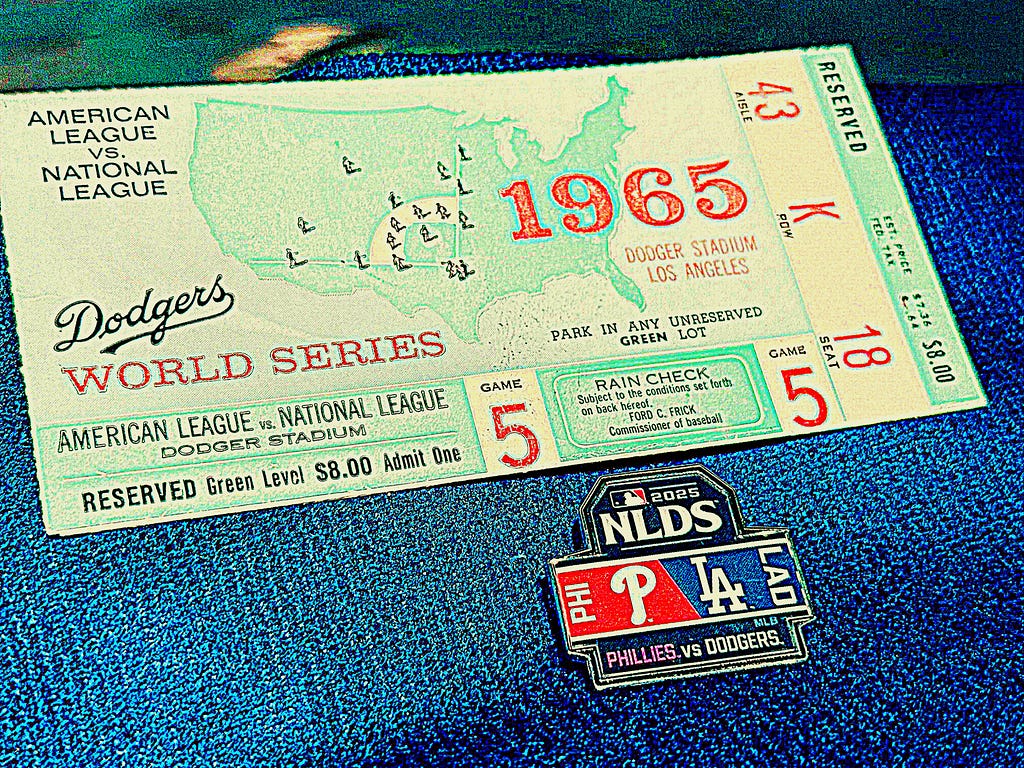
by Mark Langill
When the Dodgers clinched their first World Series title on the West Coast exactly 66 years ago with a 9–3 victory in Game 6 against the White Sox at Chicago’s Comiskey Park on Oct. 8, 1959, the celebration was temporary — at least in terms of the Dodgers’ home ballpark.
After moving from Brooklyn, the Dodgers spent their first four seasons at the Los Angeles Memorial Coliseum from 1958 to 1961 while their new venue was being designed and ultimately constructed.
Dodger Stadium opened in 1962 and hosted its first postseason contest in Game 3 of the 1963 World Series when right-hander Don Drysdale beat the New York Yankees 1–0.
Now the third-oldest ballpark in the Majors behind Boston’s Fenway Park (1912) and Chicago’s Wrigley Field (1914), Dodger Stadium today hosts its 112th postseason contest for Game 3 of the National League Division Series.
The previous 106 games span the four tiers of the playoffs: Wild Card (five), Division Series (38), League Championship Series (39) and World Series (29). The Dodgers are 67–44 (.604) at Dodger Stadium in the postseason.
When the Dodgers on Monday took a 2–0 lead against the NL East champion Phillies, it marked the third time in Los Angeles history that the Dodgers opened a best-of-five series with two road victories. The other times were during the 1974 NLCS in Pittsburgh, the 1978 NLCS at Philadelphia, and the 2008 Division Series at Wrigley Field. The Dodgers won each of those series.
Before Wednesday’s game, third baseman Max Muncy described the road atmosphere in Philadelphia as a challenge because of the intensity of the fans and the quality of the opponent. He described being calm in Game 2 during the now-famous “wheel play,” with the Dodgers clinging to a 4–3 lead in the ninth inning. Muncy fielded a Bryson Stott bunt and threw to Mookie Betts covering third base to nail Nick Castellanos running from second to third for a fielder’s choice putout.
“Your heart is racing, especially in that atmosphere,” Muncy said of Citizens Bank Park. “You hear all throughout baseball that Philly in the postseason is one of the best environments. It’s kind of tough to keep your heart rate low. Thankfully, we have a whole group of guys out there on the field that have tons of experience.”
While the Dodgers are riding a current streak of 13 trips to the postseason — the longest in franchise history and the second-most in Major League history behind the Atlanta Braves’ 14 straight between 1991 and 2005 — Muncy said reaching the postseason is something the team can never take for granted.
Neither is the chance to play at home, where the sound system is music to Muncy’s ears, especially if the fans start rocking the house. Dodger Stadium (56,000) has the largest seating capacity, and in 2025 drew 4 million fans in home attendance for the first time in franchise history.
“When you come here, the lights seem a little brighter,” Muncy said. “The music might seem a little louder. That might actually be because it is a little louder (laughs). That’s part of the perks of being at Dodger Stadium. We have that sound system, right? It sounds silly to say something like a sound system can be an advantage. But it really is. When those speakers in center field are cranking and the fans are going absolutely nuts and you feel the field shaking beneath your feet, that’s a really big advantage.
“When we have those moments, there’s arguably no other place than can get louder than Dodger Stadium, especially in the postseason when you have 56,000 or 57,000 people screaming all at the same time in a big moment. It’s pretty wild and an advantage we’ve always had here. It’s pretty wild. The guys love it. We’ve heard other players say about how cool it is to come here and play. There’s just something about this place where it always feels a little different.”
2025 NLDS: LA’s home sweet postseason home was originally published in Dodger Insider on Medium, where people are continuing the conversation by highlighting and responding to this story.
